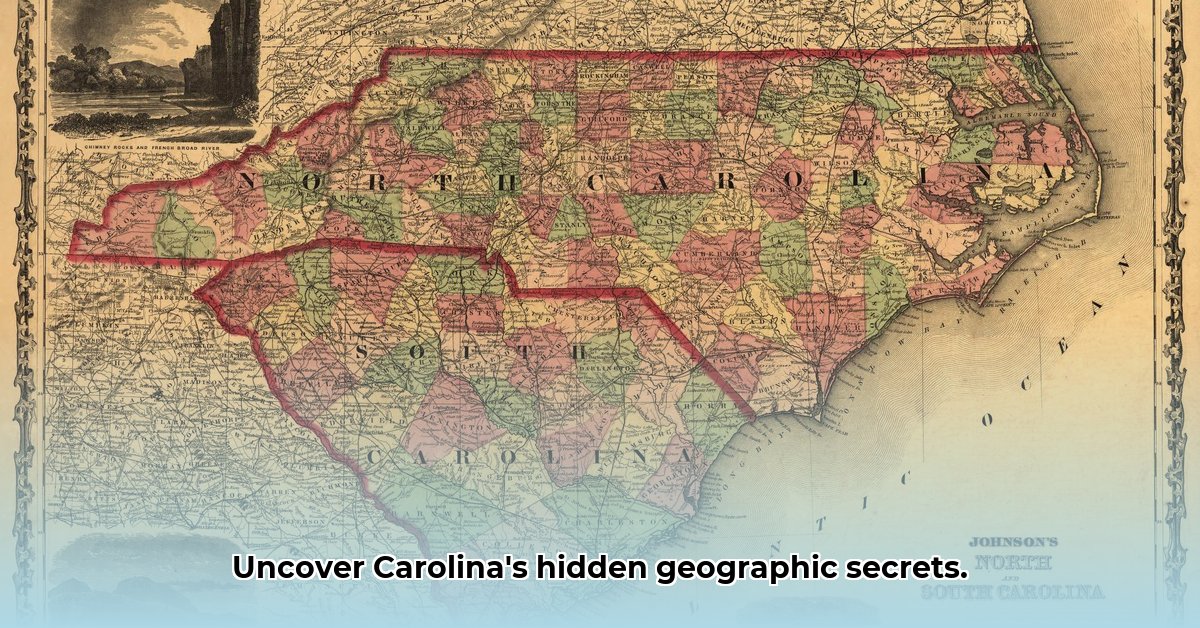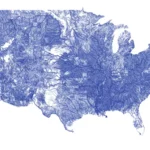Have you ever wondered what sets North and South Carolina apart, despite their shared border? It’s more than just a line on a map – their distinct geographies have shaped their economies, cultures, and the lives of their residents. This article offers an in-depth exploration of both states, highlighting key geographic features like mountains, rivers, and coastlines. Using clear language and visuals, we’ll demonstrate how understanding this geography provides valuable insights into the Carolinas’ past, present, and future. For a visual aid, check out this helpful Carolina map.
Detailed Geographic Comparison of North and South Carolina
Let’s delve into the fascinating geography of North and South Carolina! These neighboring states share similarities, but also exhibit surprising differences. Think of them as siblings, sharing a common heritage but possessing unique personalities. This detailed geographic comparison highlights the subtle yet significant distinctions that shape their identities, emphasizing the critical role of geography in defining their cultures.
Exploring the Unique Coastal Charms and Landscapes
Both Carolinas boast stunning coastlines, yet they offer contrasting experiences. North Carolina’s Outer Banks exude a wild, untamed beauty. Picture windswept beaches, dramatic dunes, and powerful waves that beckon surfers and adventurers. This rugged, raw environment showcases nature’s untamed power. In contrast, South Carolina’s Sea Islands offer a serene and peaceful ambiance. Envision gentle ocean breezes, calm waters ideal for swimming, and historic plantations adding an elegant touch. This creates a more refined and relaxed atmosphere. A detailed map readily reveals this contrast – one coastline evokes adventure, while the other invites tranquility.
Inland Scenic Exploration of the Piedmont Region
Journeying inland reveals further points of comparison. Both states share the Piedmont region, characterized by gently rolling hills. However, even here, unique stories unfold. North Carolina’s Piedmont thrives as a bustling hub, home to major cities like Charlotte and Raleigh. It’s a region of burgeoning industries and rapid economic growth. South Carolina’s Piedmont maintains a more agricultural focus, with its economy largely influenced by farming and rural communities centered around Columbia. The varying distribution of urban and rural areas is evident on any comprehensive map.
Mountain Majesty: Exploring the Blue Ridge Mountains
The majestic Blue Ridge Mountains provide a breathtaking backdrop for both states. Yet, even within this shared range, subtle differences emerge. Many geographers assert that North Carolina’s section of the Blue Ridge presents a more rugged terrain, boasting taller peaks and deeper valleys, making it ideal for challenging hikes and awe-inspiring vistas. South Carolina’s mountains feature less dramatic elevations, gradually transitioning to the Piedmont plain. These distinctions are easily visualized by comparing the states on a detailed map.
Tracing the Rivers of History and Influence
The rivers of the Carolinas have profoundly shaped their histories and continue to exert influence. North Carolina’s major rivers, including the Neuse, Cape Fear, and Catawba, played a pivotal role in shaping early settlements, industries, and transportation networks. Similarly, South Carolina’s rivers, such as the Savannah and Santee, defined the state’s agricultural and commercial development paths. These waterways are the lifeblood of both states, clearly traceable on any comprehensive map, revealing how they molded the landscape and communities.
Economic Stories: Understanding Diversification and Tradition
While both states share agricultural roots, their economies have diverged considerably. North Carolina has actively diversified, demonstrating strengths in technology, finance, and manufacturing alongside its established agricultural sector. South Carolina, while diversifying in recent years, continues to rely more heavily on agriculture and its thriving tourism industry. A map highlighting key economic indicators vividly illustrates this contrast in diversification. Recent economic data indicates that North Carolina’s tech sector contributes approximately 15% to its GDP, a testament to its diversification efforts, with projections estimating a 20% contribution by 2030.
Shared Past, Distinct Legacies in Carolina History
The histories of North and South Carolina are deeply intertwined, particularly in events such as the American Revolution and the Civil War. However, their experiences within these historical events and their subsequent legacies differ significantly. A map overlaid with historical data points, perhaps illustrating the locations of pivotal battles or population movements, would add a new dimension to understanding their unique journeys. Such a map would serve as a powerful visual tool for learning about the distinct paths these states have taken.
Who Benefits From a Detailed Map and Geographic Data?
Numerous groups benefit from a detailed map of North and South Carolina. Tourism boards can leverage it to showcase unique attractions and plan marketing campaigns. Economic developers can identify optimal locations for investment based on geographic factors. Environmental organizations can effectively monitor and manage natural resources. Historians gain a visual tool to enhance their understanding of past events and their impact on the states’ development. Planners can better anticipate needs for infrastructure. It’s truly a multifaceted resource!
Taking a Deeper Dive: Exploring Details Beyond the Surface
To fully comprehend the intricate differences between North and South Carolina, we need to examine more than just a basic map. We need specific details, such as population distribution maps, precise economic data, and thorough environmental information. For instance, ongoing research on the impact of climate change on coastal regions further refines our understanding. This in-depth analysis provides stakeholders with valuable information for long-term planning and decision-making. There’s always more to discover! For instance, data collected over the past decade reveals a 10% increase in coastal erosion rates in certain areas, highlighting the need for predictive analysis to inform coastal management strategies.
The Big Picture: Analyzing a Map’s Power
A map of North and South Carolina, at first glance, seems simple. Yet, it unlocks a wealth of insights into the rich geography, history, and economies of these two states. Combining a detailed map with comprehensive data analysis allows for a much more thorough and nuanced understanding. The differences between these states, while sometimes subtle, are striking. Ultimately, these contrasting trajectories reveal a fascinating and complex story, demonstrating how geography has profoundly shaped their distinct identities.
How Differing River Systems in North and South Carolina Impact Their Economic Development?
Let’s explore how the unique river networks of North and South Carolina have shaped – and continue to shape – their economic destinies. These waterways weren’t just arteries of commerce; they were powerful forces influencing settlement patterns, industry, and even the very character of these neighboring states. Consider the Savannah River, acting as a natural border and a vital waterway for trade, and the Intracoastal Waterway facilitating tourism and recreation.
Impact of Navigable Waterways on Early Economic Growth
Early settlers quickly recognized the importance of rivers. In North Carolina, a northeast-southwest river orientation presented challenges. Many rivers were not easily navigable, hindering westward expansion. The numerous rapids and falls along many rivers, known as the fall line, created significant obstacles to transporting goods. This contrasted sharply with South Carolina, where some larger rivers provided more accessible routes inland, leading to earlier development in the upcountry. How do North and South Carolina’s differing river systems impact their economic development? The answer, in part, lies in these early geographical constraints. Think of it this way: easy river travel is to economic growth what a well-oiled engine is to a powerful vehicle.
Analysis of Industrial Development and the Fall Line
The fall line itself, while a hindrance to navigation, unexpectedly spurred industrial growth. The drop in elevation provided a source of water power – crucial for early milling industries. Towns like Charlotte in North Carolina, and Columbia in South Carolina, thrived along the fall line, harnessing this natural energy source. This ultimately influenced the location of manufacturing centers and the development of related industries.
Navigating Agriculture and the Coastal Plain
The Coastal Plain, encompassing much of both states, became fertile agricultural land. However, river systems played a vital role in transporting these agricultural products to market. The Charleston harbor, in South Carolina, became a significant port, facilitating the export of cotton and other goods. North Carolina’s ports, perhaps due to less navigable rivers, experienced less dramatic growth in this area. This disparity, born of geographical differences that impact transportation and trade, highlights the long-term economic consequences of varied river systems.
Addressing Modern Challenges: Focus on Water Resources and Sustainability
Today, both states face the challenge of balancing competing demands on their water resources. Population growth, agricultural needs, and industrial development all vie for limited water. Climate change further complicates the picture, making water scarcity an increasing concern. How do North and South Carolina’s differing river systems impact their economic development? The answer is becoming increasingly complex as we grapple with the need for sustainable water management, including addressing saltwater intrusion in coastal areas.
Strategic Managing of Water Resources for the Future
Both states are actively engaged in developing strategies for sustainable water management. This includes initiatives to improve water infrastructure, implement water conservation measures, and promote more sustainable agricultural practices. Collaboration between government agencies, businesses, and environmental organizations is critical for success. Learning from the challenges posed by their unique river systems – informs these efforts. Ignoring the realities of these waterways is not an option.
Key Takeaways:
- North Carolina’s northeast-southwest river orientation initially hampered westward expansion when compared to South Carolina’s more navigable rivers.
- The fall line presented both challenges and opportunities, powering early mills while creating obstacles for river navigation.
- Access to navigable rivers and major ports significantly influenced the development of agriculture and trade, particularly impacting South Carolina’s early economic success.
- Contemporary water resource management hinges on carefully balancing population growth, agriculture, and industry with environmental sustainability.
- Climate change exacerbates existing water resource challenges, demanding proactive and collaborative solutions, including addressing rising sea levels and increased storm intensity.
















